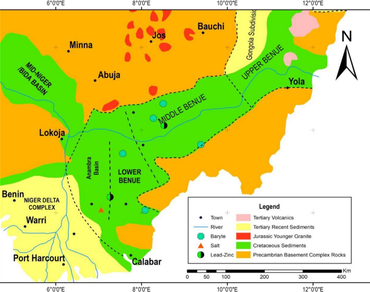Origin of the brines associated with the lead–zinc–barite–fluorite deposits in Benue Trough, Nigeria: Evidence from stable isotope studies
Afolabi Olubukola O., Ogundipe Ibukun E., Ogundana Ayodeji K.
Research Articles | Published: 14 January, 2024
First Page: 725
Last Page: 730
Views: 3358
Keywords: Brine, Origin, Lead–zinc–barit–fluorite deposits, Benue Trough, O–H isotopic ratios
Abstract
Nigerian sedimentary lead–zinc–barite–fluorite-deposits which covers along 600 km long Benue-Trough extends from south of Abakaliki District in Lower-Benue to Zurak-Wase Districts in Upper-Benue. Highly saline subsurface waters issuing out as springs, streams and wells are quite ubiquitous throughout the mineralogical-belts. This research intends to determine the origin of hydrothermal fluids responsible for deposition of lead–zinc–barite–fluorite deposit in basin. Brine samples were collected from three principal sources (springs, wells and stagnated-streams) and hydrogen and oxygen isotope composition of the brines were analysed using well established analytical methods. Isotopic ratios were then determined on H2 and CO2 gases in Micromass Mass-Spectrometer. H- and O-isotopic studies of these subsurface brine indicate fairly large range of both δD and δO18 values between − 13 and + 10‰ and − 14 and + 0.8‰, respectively. Salinity of these waters were also highly variable from 0.1 to 14.2 g/L of Cl. If brine with Cl contents less than 1 g/L are considered, the δD values fall within − 15‰ to − 5‰ which closely represent the isotopic composition of present day meteoric waters in Benue-Trough. Heavier δD values were interpreted to represent fossil meteoric or basinal brine. The close similarity between isotopic compositions of brine and lead–zinc deposits suggest that present day meteoric waters is probably replica of paleo-formation waters from which the sulphides were deposited.

References
Bigeleisen J, Perlman ML, Prosser HC (1952) Conversion of hydrogenic materials to hydrogen for isotopic analysis. Anal Chem 24:1356
Clayton RN, Friedma I, Graaf DL, Mayeda TK, Meents WF, Chimp NF (1966) The origin of saline formation waters. J Geophys Res 71:3869–3882
Epstein S, Mayeda T (1953) Variation of 18O content of waters from natural sources. Geochim Cosmochim Acta 4:213–224
Fatoye FB, Ibitomi MA, Omada JI (2014) Lead–zinc–barites mineralization in the Benue Trough. Adv Appl Sci Res 5(2):86–92
Fleischer E, Goldberg M, Gat JR, Magaritz M (1977) Isotopic composition of formation waters from deep drilling in southern Israel. Geochim Cosmochim Acta 41:511–525
Ford SO (1981) The economic mineral resources of the Benue Trough. Earth Evol Sci 2:154–163
Hitchton B, Friedman I (1969) Geochemistry and origin of formation waters in the western Canada sedimentary basin—I. Stable isotopes of hydrogen and oxygen. Geochim Consmochim Acta 33:1321–1349
Muehlenbachs K (1998) The oxygen isotopic composition of the oceans, sediments and seafloor. Chem Geol 145(3–4):263–273
Offodile ME (1976) the geology of the middle Benue Nigeria. Publ. from Paleont. Inst. University of Upsala, Special volume 4
Ogundipe IE (2017) Thermal and chemical variations of the Nigerian Benue Trough lead–zinc–barite–fluorite deposits. J Afr Earth Sc 132:72–79
Ogundipe IE, Ogundana AK, Afolabi OO, Olutomilola OO (2017) Lead isotopic variation and source of the lead in the lead–zinc–minaralization of the Benue Trough, Nigeria. Nigeria J Min Geosci Soc 53(2):153–160
Okeke AI, Anike LO, Ezeh H, Okoyeh EI (2018) Geochemistry and ore genesis of Ishiagu galena-sphalerite mineralization, S. E. Nigeria, pp 1–11
Olade MA (1976) On the genesis of lead–zinc deposits in Nigeria’s Benue rift (aulacogen). A re-interpretation. J Min Geol Nigeria 13:20–27
Orajaka S (1973) Salt water resources of East Central State of Nigeria. J Min Geol 7(1 and 2):23–28
Oslon C, Haley ND, Johnston DT (2022) Oxygen isotope insights into the Archean Ocean and atmosphere. Earth Planet Sci Lett 591:117603. https://doi.org/10.1016/j.epsl.2022.117603
Sheppard SMF, Langley KM (1984) the origin of Saline formation waters in Northeast England Application of stable isotopes. Trans Inst Min Metall Sedim B Appl Earth Sci 93B:195–200
Sheppard SMF (1986) Characterization and isotopic variations in natural waters. In: Valley JW, Taylor HP Jr, Oineil JR (eds) Stable isotopes in high temperature geological processes, vol 16. Reviews in mineralogy. pp 165–181
Taylor HP Jr (1974) The application of oxygen and hydrogen isotope relationships in hydrothermal mineral deposits. In: Barnes HL (ed) Geochemistry of hydrothermal ore deposits, 2nd edn. pp 236–277
Tijani MN (2004) Evolution of saline waters and brines in the Benue-Trough, Nigeria. Appl Geochem 19(9):1355–1365. https://doi.org/10.1016/j.apgeochem.2004.01.020
Uzuakpunwa AE (1981) The geochemistry and origin of the evaporate deposits in the southern half of the Benue Trough. Earth Evol Sci 2:136–138
Author Information
Department of Geology, Afe Babalola University, Ado-Ekiti, Nigeria